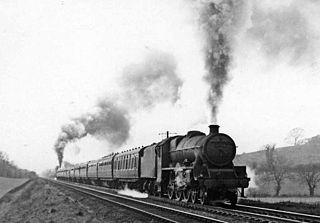
The Lickey Incline, south of Birmingham, is the steepest sustained main-line railway incline in Great Britain. The climb is a gradient of 1 in 37.7 for a continuous distance of two miles (3.2 km). Constructed originally for the Birmingham and Gloucester Railway (B&GR) and opened in 1840 it is located on the Cross Country Route between Barnt Green and Bromsgrove stations in Worcestershire.
The Birmingham and Gloucester Railway (B&GR) was the first name of the railway linking the cities in its name and of the company which pioneered and developed it; the line opened in stages in 1840, using a terminus at Camp Hill in Birmingham. It linked with the Bristol and Gloucester Railway in Gloucester, but at first that company's line was broad gauge, and Gloucester was a point of the necessary but inconvenient transhipment of goods and passengers onto 4 ft 8+1⁄2 in gauge that became the national standard. Nearly all of the original main line remains active as a "trunk" route, also known as an arterial route or line.

Cheltenham Spa railway station is a railway station serving Cheltenham in Gloucestershire, England. Situated on the Bristol-Birmingham main line, it is managed by Great Western Railway and is about one mile from the town centre. The official name of the town is simply Cheltenham, but, when the station was renamed in 1925, the London, Midland and Scottish Railway chose to add Spa to the station name. The station is a key regional interchange and is the fifth busiest rail station in South West England.

Gloucester railway station is a railway station serving the city of Gloucester in England. The station was originally built as the terminus of the Birmingham and Gloucester Railway in 1840, but the arrival of the Bristol and Gloucester Railway and Cheltenham and Great Western Union Railway in 1844, and then conversion to a through station for the South Wales Railway in 1851 resulted in a very complex layout. Subsequent closures and rationalisation have left Gloucester with a station that is located off the main Bristol-Birmingham line, meaning Great Western Railway services must reverse, while CrossCountry and Transport for Wales services continue to Newport. The station is 114 miles 4 chains (183.5 km) from the zero point at Paddington, measured via Stroud.

Ashchurch for Tewkesbury is a railway station serving the town of Tewkesbury and village of Ashchurch in Gloucestershire, England. The station is located less than 1⁄4 mile (400 m) from junction 9 of the M5 motorway and located on the main Bristol–Birmingham main line 7+1⁄4 miles (11.7 km) north of Cheltenham Spa and was opened on 1 June 1997 by Railtrack. There are regular bus connections from the station to Tewkesbury town centre, which is located two miles to the west. Apart from a few peak journeys on service 41/42 and 71, there are no bus connections in the opposite direction from Tewkesbury to Ashchurch.

The Birmingham and Derby Junction Railway was a British railway company. From Birmingham it connected at Derby with the North Midland Railway and the Midland Counties Railway at what became known as the Tri Junct Station. It now forms part of the main route between the West Country and the North East.
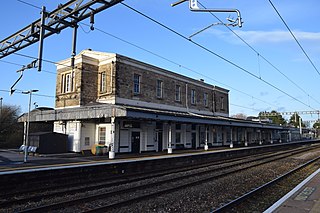
Swindon railway station is on the Great Western Main Line in South West England, serving the town of Swindon, Wiltshire. It is 77 miles 23 chains down the line from the zero point at London Paddington and is situated between Didcot Parkway and Chippenham on the main line. It is managed by Great Western Railway, which also operates all the trains.

Barnt Green railway station serves the village of Barnt Green, North Worcestershire, England. It is situated 9+1⁄2 miles (15.3 km) south west of Birmingham New Street. The station, and all trains serving it, are operated by West Midlands Trains.
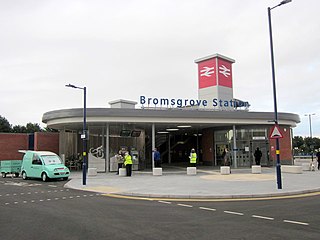
Bromsgrove Railway Station serves the town of Bromsgrove in Worcestershire, England. It is located at the foot of the two-mile Lickey Incline which ascends at a gradient of 1-in-37.7 towards Barnt Green on the line between Birmingham and Worcester. Bromsgrove is managed by West Midlands Railway. The current station opened on 12 July 2016, replacing an older station located slightly to the north.
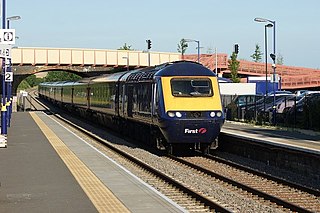
Honeybourne railway station serves the village of Honeybourne in Worcestershire, England. Opened in 1853, it is on the Cotswold Line and was formerly a busy junction with five platform faces, also serving trains on the Great Western Railway's Honeybourne Line between Cheltenham Spa and Stratford-upon-Avon, which formed part of a strategic route between the West Midlands and the West of England.
The Oxford, Worcester and Wolverhampton Railway (OW&WR) was a railway company in England. It built a line from Wolvercot Junction near Oxford to Worcester, Stourbridge, Dudley and Wolverhampton, as well as some branches.

Mangotsfield railway station was a railway station on the Midland Railway route between Bristol and Birmingham, 5.1 miles (8.2 km) north-east of Bristol Temple Meads and 82 miles (132 km) from Birmingham New Street, serving what is now the Bristol suburb of Mangotsfield. The station was opened in 1845 by the Bristol and Gloucester Railway, but had very little in the way of passenger amenities. The station was resited in 1869 to serve the new Mangotsfield and Bath Branch Line, and became an important junction station with extensive facilities and six platforms. Passenger footfall however failed to match the station's size, though at its peak eight staff were employed. The station closed in 1966 when services to Bath ended as part of the Beeching cuts, and the line through the station closed in 1969. The railway became a cycle path in the 1980s, and is a popular resting point on the route as several of the station's walls and platforms are still in situ.
The Slamannan Railway was an early mineral railway between the north-eastern margin of Airdrie and Causewayend on the Union Canal, near Linlithgow, Scotland.
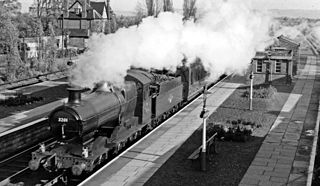
Churchdown railway station was situated on the main line between Gloucester and Cheltenham Spa. It served Churchdown and surrounding areas.

Yarnton Junction was a three-platform station serving the village of Yarnton, Oxfordshire. It was built in 1861 at the junction of the Oxford, Worcester and Wolverhampton Railway and Witney Railway, north of Oxford. British Railways closed the station to passengers in 1962 and it was demolished c. 1965.
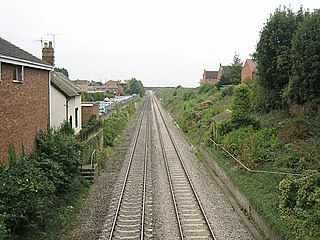
Bredon railway station was on the Birmingham–Gloucester railway line to the north of Ashchurch for Tewkesbury railway station. The station closed in 1965.
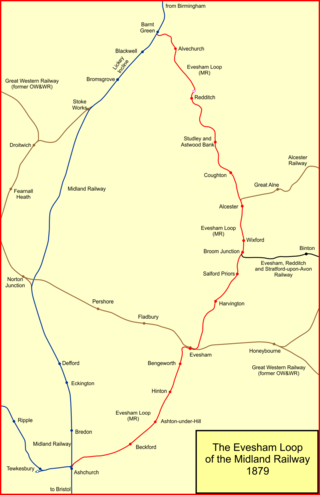
The Evesham branch line is a mostly disused English railway line running from Barnt Green via Redditch, Alcester and Evesham to Ashchurch. It was sometimes known as the Gloucester loop line of the Midland Railway.
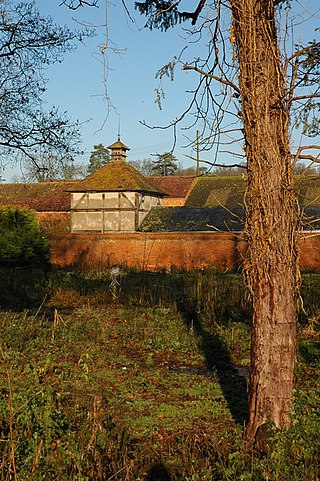
Spetchley is a hamlet and civil parish in Worcestershire, England, that lies in the district of Wychavon, half a mile from Worcester, along the A44 road. Spetchley contains Spetchley Park, a country mansion with extensive gardens.
Abbots Wood Junction railway station was an early railway station in England, close to Worcester. The station, 68 miles 60 chains from Derby, was opened by the Midland Railway in November 1850 on the route of the former Birmingham and Gloucester Railway. Originally named Worcester Junction, it was renamed Abbot's Wood Junction on 1 March 1852, and it was closed on 1 October 1855.

Swiftsure was first of eight or more similar locomotives with a single pair of driving wheels built by George Forrester and Company (Forresters) from 1834. The tank variant was the first passenger tank engine to enter service in the world.

















